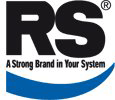The Kiel Canal in Schleswig-Holstein connects the North and Baltic Seas and makes the longer detour around Denmark of about 900km unnecessary. One hundred instead of 1,000km not only saves fuel, but especially time. As each hour of operation costs money, it is obvious that the petrol stations along this waterway depend on time savings as well as safe loading technology. Bominflot in Kiel relies on RS for this.
Safe loading, even in rough seas
Bominflot’s tank farm of is located immediately behind the Holtenau lock. For all ships on their way from the Baltic Sea to the North Sea, it really is the premier address for the storage of petroleum products. For land-sea hose connections this is always associated with particular strain on hoses and fittings. On the land side, for each coupling the heavy hoses are pulled over the rough ground. Current, wind and swell have an effect on the ship that – despite being tied to the pier with mooring lines – is always moving. If, for instance, a mooring line loosens, a critical situation arises. No hose line can hold a ship that is drifting away. It would tear in its course or at the coupling, and the medium would run freely into the sea until the further inflow is shut off manually.
Breakaway couplings from RS DN 80 to DN 300
Breakaway couplings are compulsory here, as they can simultaneously perform two functions in the case of an accident: a separating mechanism that responds sufficiently far from the maximum load of the hose separates the line between the mobile unit and the loading system via a preset cable winch. At the same time, an automatic fastening system prevents leakage of the medium at both separating points.
Right from the start, Bominflot has been relying on the loading safety provided by the RS brand, namely breakaway couplings type ABV-S in the dimensions 150 and 200 DN. Hoses with this cross section are today’s standard for the loading of ships. If, for example, a volume of about 300,000 litres gas oil flows through the hose lines for larger vessels, the hose cross section and thus the hourly flow rate is a decisive factor for the feed duration. For this, even a DN 200 hose line is often too small. So the RS developers designed an ABV-S with the nominal width DN 300.
When the new breakaway couplings completed the first trial runs, Bominflot was thrilled. If a tanker used to remain at the pier in order to discharge its load for a period of approximately 12 hours, the new ABV-S breakaway couplings reduced this time to about eight hours. In this order of magnitude the investment costs are repaid within a reasonable period of time.
This benefit is described in detail in the new free Bominflot reference brochure. Further information is available on our website.

